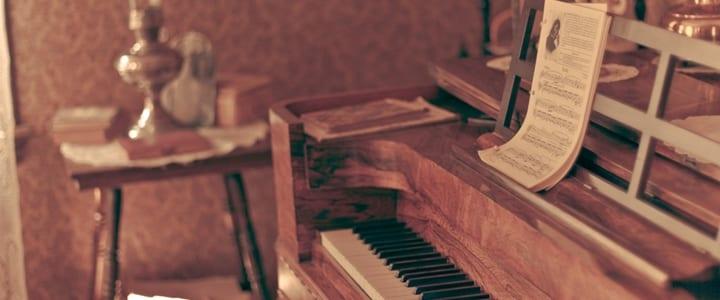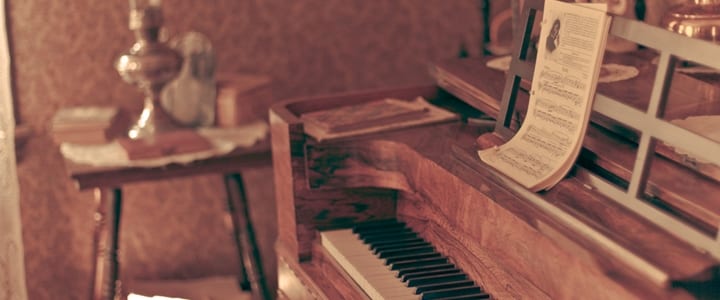You may have heard of guitar tabs, but what about tabs for pianists? Learn about how to read piano tabs, the difference between tabs and lead sheets, and more in the guest post by Tulsa, OK teacher Chris F…
When learning songs on piano, you’ll find that there are a few ways the music can be notated. Often if an artist is popular enough, a music publishing company will notate their music and sell it, often by the album. This notated version of the music is generally referred to as a lead sheet. Lead sheets often include a notated melody, notated accompaniment, and chord symbols.
There are some pros and cons to using a lead sheet:
Pros-
- If you can read music well, lead sheets are a quick, easy way to play some of your favorite piano songs.
- Figuring out the music by ear can take forever. A lead sheet takes out the guesswork and allows you to be certain you’re playing the correct notes.
Cons-
- The piano part provided in lead sheets is an arranged part, meaning that the publisher made it up to sound like the song and added the singer’s melody on top of the part. This is great if you want to perform a solo version of the song on piano. It doesn’t help, however, if you’d like to provide your own vocals or want to know exactly what the pianist is playing on the recording.
- Lead sheets are rarely edited by actual, gigging musicians, which means that the chord diagrams given are copied and pasted and almost always unrealistic.
- Lead sheets take time and money to publish. This means that they are almost never free and sometimes not available at all for less popular songs.
The alternative to lead sheets are piano tabs, otherwise known as chord charts. Chord charts are simply the lyrics of a song with the chords listed above the words. There is never any sheet music provided for chord charts. Instead, the player must know most basic chord types (major and minor) and play the right chord over the right word. Exactly how the chord is played on the piano is up to the player.
Learning how to read piano tabs or chord charts has many advantages over lead sheets:
Pros-
- Chord charts are widely available for free on the Internet. Ultimate-guitar.com has the largest chord chart library, with thousands of user-submitted charts. Despite the name, this site is a valuable resource for pianists, as well as any other musician who uses chord charts.
- Chord charts force pianists to figure out the specific notes, rhythms, and licks on their own. At first this can be tricky, but this skill comes steadily with time. This kind of self-reliance is what is needed to play piano chords well.
- Sheet music is a valuable tool, but it’s more valuable to be a musician who can play piano tabs, considering their easy availability online.
Cons-
- Chord charts don’t have all the little details that lead sheets have. Usually these details are easy to figure out in a standard pop song. For more difficult songs with hard-to-remember rhythms or licks, a lead sheet might be more easier to read.
- You have to know chords well to play chord charts well. Luckily, most popular songs only have 3-5 chords in them. But for songs with 10 or more chords, a lead sheet might be easier until all those chords are memorized and easy to play.
- For certain types of music, such as classical, jazz, or musical numbers, lead sheets are standard. These types of music employ many types of chords and feature specialized piano parts that are easier to read than to memorize.
Here are some tips for learning chord charts:
- Learn the basic kinds of chords – major and minor. There is no symbol for a major chord – C major is shown as simply C. Minor chords are indicated by a lower case m. C minor is shown as Cm.
- Start learning songs with only these four chords: C, F, G, and A minor. These four chords use only white keys and are easy to play. These chords also go well together. There are many songs that use just these chords, such as Bill Withers’ “Stand by Me” or The Lumineers’ “Ho Hey”.
- If you don’t know a complex chord, such as Cadd9 or D/F#, just look at the first note and play that chord. For example, Am11 can be read as Am, and C7 as C.
- Sometimes the people who put together piano tabs do a great job, and sometimes they miss the mark. Try to choose well-reviewed charts. Let your ear decide if something sounds correct.
- Always remember to try and play to the beat of a song. Often, chords are held for two, four, or eight beats. Use the words as a loose guide, but remember that some chords change when there are no words being sung.
Learning how to read piano tabs and lead sheets are both useful. Practice reading both and you’ll be ready to jam along to any type of song. Happy practicing!
 Chris F. teaches guitar, piano, music theory, and more in Tulsa, OK. He has been active in collegiate percussion ensembles, marching and concert bands, various choirs, chamber music groups, jazz combos, an award winning jazz big band, bluegrass combos, drum and bugle corps, and private lessons on several instruments, as both a section leader and as a teacher. Learn more about Chris here!
Chris F. teaches guitar, piano, music theory, and more in Tulsa, OK. He has been active in collegiate percussion ensembles, marching and concert bands, various choirs, chamber music groups, jazz combos, an award winning jazz big band, bluegrass combos, drum and bugle corps, and private lessons on several instruments, as both a section leader and as a teacher. Learn more about Chris here!
Photo by Ricky Romero
Suzy S.


